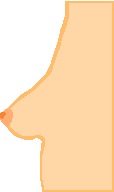 |
The ptotic, (saggy) breast with little to no volume is very common after pregnancy, breastfeeding, weight loss and aging - or all four combined. Although many young mothers may experience this after pregnancy and breast feeding, where aging is not a factor. However it is truly dependent upon the individual. Regardless, the augmentation mammoplasty procedure can substantially improve this breast type. Sometimes a lift is needed.
|
 |
The ptotic, (saggy) breast with much volume will more than likely need a lift. The good thing about this breast shape is that there is still a substantial amount of breast tissue to cover the implant. Too little tissue can result in a palpable implant. The same breast but without the volume would of course require a large implant and a lift.
|
 |
This case is more common than you think. In my opinion, smaller breasted women do come out with outstanding results with implants. Usually this breast type will need to have the implant placed under the pectoral muscle. It is also possible to have the full sub muscular placement with the use of the serratus muscles and the rectus abdominus fascia as well as the pectoralis major. Rippling can be a problem with smaller breasted women, although women with very little breast tissue and thin skin may qualify for silicone filled implants.
|
 |
This is more of a breast anomaly than a shape but none the less it is a situation which can be corrected. Often called Tubular breasts or constricted breasts, the problems are usually twofold. One, the base of the breast which usually isn't wide enough. And two, the nipple and areola complex is sometimes partially augmented due to the herniated breast tissue. The base of the breast can be dissected from the chest wall just like any other skin and widened (or expanded) to permit the implantation of a breast prosthesis. The areolae - which are usually enlarged and/or tubular shaped, can be reduced and also be internally sutured in a crisscross pattern underneath it to keep the tissue from herniating once again. This procedure should most certainly be performed by a very qualified surgeon.
|
 |
Augmented nipple/areola complex (called usually snoopy): This shape is usually due to herniation of the tissue, lobules and fat without proper containment by the connective tissue under the areolae complex. This can be corrected with a Benelli-mastopexy, areolae reduction and sometimes with the aid of permanent sutures in a star fashion placed under the areolae complex. The permanent sutures act like a pseudo-containment net for the underlying breast tissue/fat and isn't offered by all surgeons.
|
 |
Pectus carinatum congenital chest deformity (pigeon chest) with ptosis: This isn't exactly a breast shape, per se, but rather a deformity or divergence of the chest. The ribs usually protrude as can the sternum. Sometimes the ribs stick out much further than the sternum causing lack of self esteem or self consciousness of the breasts. Breast implants can give the illusion of a normal chest. The opposite of Pectus carinatum is pectus excavatum where the chest sinks in, sometimes called sunken chest, There are therapies that may help correct P.E. although if not desired, breast implants or pectoral implants (in males) will lessen the obviousness of the disorder.
|
Of course there are many more shapes and variances but these are the basic breast forms in patients who seek breast lifts and breast augmentation. For more information on the common complaints or requests regarding a post-operative result - or reasons many patients decide to have breast augmentation please visit our next section.
|










